
Most 12 Common Lawn Diseases
If you’ve ruled out pests and weeds as the problem causing unsightly patches in your lawn, then it’s time to examine common lawn diseases as the culprit.
The following is a list of common lawn diseases that will affect even the best of lawns if not taken care of upon the first sign of disease.
1. Brown Patch Lawn Disease
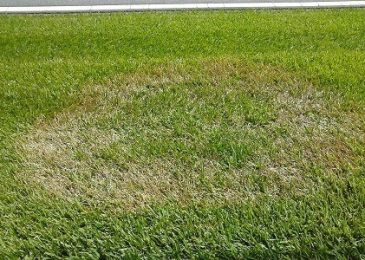
“Brown Patch” is also called a summer patch. It kills a circular area of the grass up to 2 feet in diameter. The infected area will change color and develop a likeness to the frog’s eyes, having a circular spot surrounded by a discolored ring of grass. The grass in these patches will probably be thin.
The problem causing the ring is a fungus that flourishes in the warm temperatures and especially with damp conditions caused by thatch. Excessive nitrogen fertilization and poor drainage encourage the disease. St. Augustine grass is particularly vulnerable.
If your lawn is infected with “Brown Patch”, apply a flowable sulfur fungicide to the infected areas every three to five days until the symptoms disappear. Make sure you remove any underlying thatch with a rake or dethatcher to avoid the problem from reoccurring. Also, avoid applying heavy doses of nitrogen fertilizers to your lawn and improve drainage if necessary.
2. Dollar Spot
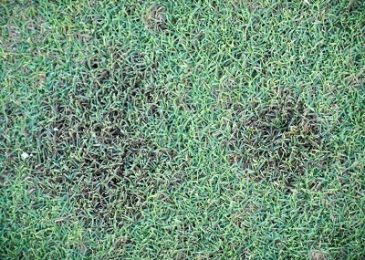
Dollar spot is named as such because it creates a tan or straw-colored spot in your lawn the size of a silver dollar. The dollar spot is a fungus that thrives on dry, undernourished lawns. Infected lawns will show small, white, cobwebby spots in the morning that turns brown later in the day. These patches will grow together to form larger patches.
The best way to treat a dollar spot is to apply a flowable sulfur fungicide to the infected areas every three to five days until the spots are gone. Frequent light applications of nitrogen will help your lawn recover after treatment, and regular mowing will cut the tips off of the infected grass, eventually eliminating the damage created by the fungus.
3. Fairy Ring Lawn Disease
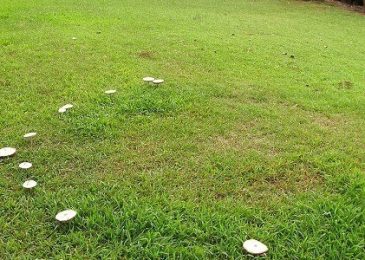
If your lawn shows bright green circular areas that look like they are growing more rapidly than the rest of your lawn, then you probably have a fairy ring. Fairy ring is a fungus that causes the outer ring to turn brown and eventually will affect the overgrown patches of the ring as well. A ring of mushrooms will often grow around the edge of an infected area.
Fairy ring often occurs after an extremely rainy period. It thrives when moisture builds upon the lawn. Fortunately, it’s usually only a problem in the Pacific Northwest.
If your lawn is infected by a fairy ring, you must dig out the infected area to a depth of 2 feet and extending 1 foot all around the diseased patch. Then you must backfill the infected area with a good mix of soil and replant seed for new grass growth.
4. Fusarium Blight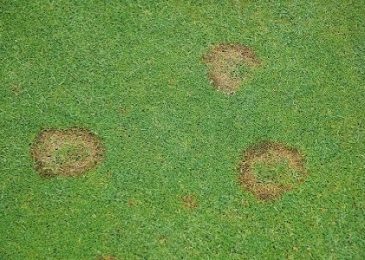
Fusarium blight will cause reddish-brown spots two to six inches in diameter. These spots will turn tan, then eventually yellow.
They tend to occur in areas of the lawn where the grass is stressed. Grass infected by this disease will show rot at the roots and crowns.
Most will be covered with pink fungal threads that are a definite diagnosis of Fusarium blight. This type of disease thrives under heat and humidity and can ruin an entire lawn if not controlled.
To control this disease, mow the grass high and discard all clippings. Don’t use them in your compost pile. Also, remove all thatch and refrain from fertilizing the lawn in late spring or early summer until the problem is under control.
5. Leaf Smut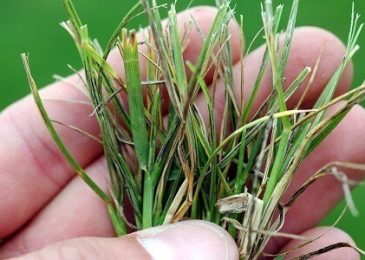
Leaf smut will show a pale green appearance and stunted growth to your grass. The individual grass blades may have a black stripe, which is a further indication of leaf smut.
The black stripes develop, then rupture and expose masses of spores to the other blades around the infected blade. The blades will curl, tear easily and will sometimes look shredded. This disease is more active in the spring and fall because it thrives under cool and moist conditions.
You can control leaf smut by mowing the lawn frequently and cutting off the infected tips of grass, then removing the clippings from the lawn. Follow a good regimen of watering and fertilizing to boost the strength of the grass and prevent further infection of the smut.
6. Leaf Spot
The reddish-brown to purplish-black spots on grass is caused by a fungus called leaf spot. Eventually, infected blades will shrivel and the crowns and roots of the grass will rot.
This will leave you with irregular patches of thin grass that develop over the lawn.
This fungus is most prevalent when the weather is cool and moist.
To control Leaf Spot, spray the lawn with a flowable sulfur fungicide every three to five days until all the signs of the fungus disappear. Correct any drainage and aeration problems that may be present in your yard to keep the problem from reoccurring.
7. Necrotic Ring Spot

This is a disease that is promoted by the thatch build-up and poor aeration. The necrotic ring spot causes grass to look tattered. Brown rings will develop over the lawn, sometimes hitting suddenly in an otherwise healthy-looking lawn.
You can control the ringspot by removing the thatch and mowing the grass high. Continue to feed and water the grass regularly to reduce stress and promote its health after treatment.
8. Powdery Mildew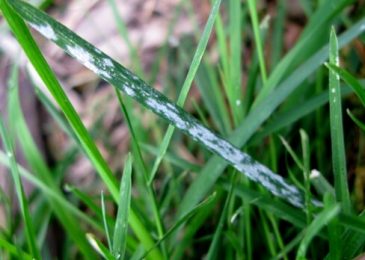
A thin white powdery coating on your grass is a sure sign of powdery mildew. This mildew often hits shaded areas when the nights are cool.
Heavily infected lawns will show grass turning yellow, then eventually dying.
To treat this disease, spray your lawn with a flowable sulfur fungicide every three to five days until all symptoms disappear. Be careful not to overwater or over-fertilize the lawn.
9. Pythium Blight
Pythium blight is also called cottony blight or grease spot. It’s caused by a fungus and will kill spots or streaks of grass when infecting a newly established lawn.
The first sign of this type of blight is a blackened, water-soaked appearance of patches of grass in your lawn.
During humid weather, you may also see a cottony growth on the grass. This fungus can infect an area as small as a few inches, or as large as a few feet. The infected grass will lie flat on the ground.
Prevention is the best medicine as this fungus is virtually impossible to stop once it starts. It affects northern lawns the most and can be prevented with careful watering. Be sure and water your lawn in the early morning instead of the late evening hours. This disease is more likely to occur when lawns are left wet overnight.
10. Red Thread or Pink Patch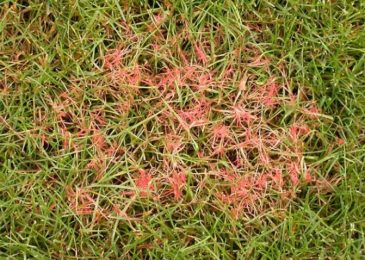
Your lawn may be infected with this disease if you develop circular patches of scorched grass.
If you look closer, you’ll probably find red or rusty threads on the blades.
This fungus is most prevalent in the Northeast and Pacific states because they thrive under cool and damp conditions.
Red Thread or Pink Patch can be controlled with regular watering and feeding. Mowing will cut off the infected blade tips.
11. Rust
Rust occurs when your lawn, or sections of your lawn, have an overall rusted hue to it.
If you look more closely at the grass, you’ll probably find a yellowish-orange or reddish-brown powdery residue on the blades.
This is rust. Rust usually occurs in late summer and early fall when the weather is still warm and dry. It is especially damaging to certain types of bluegrass.
To control rust, spray your lawn with a flowable sulfur fungicide every three to five days until all the symptoms disappear. Then fertilize with a foliar spray and mow frequently being sure to catch and discard all the clippings to prevent reinfestation.
12. Snow Mold
This mold is named “snow mold” because it can occur even under the cover of snow. There are two different types of fungi that are responsible for snow mold.
The first is a fungus that produces typhus blight, or gray snow mold. This type is most common in lawns that have been covered by heavy snow throughout the winter. When the snow melts in the spring, patches of white or gray fungus covers the lawn in two-foot diameter sections.
The other type of snow mold is the Fusarium patch. In the spring, white or pink dead patches of matted grass remain in one-foot sections or larger across the lawn. This type of fungus can occur even if it doesn’t snow.
For both, you need to apply a flowable sulfur fungicide to the infected areas every three to five days until the symptoms disappear. Make sure you aerate the soil and improve drainage as needed to prevent this from reoccurring the following winter. Also, avoid excessive nitrogen fertilization in the fall.









